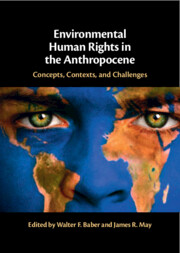Book contents
- Environmental Human Rights in the Anthropocene
- Environmental Human Rights in the Anthropocene
- Copyright page
- Contents
- Contributors
- Acknowledgements
- Introduction
- 1 Framing Environmental Human Rights in the Anthropocene
- 2 Protecting Environmental Human Rights for Future Generations
- 3 Taking Environmental Rights in the Anthropocene Seriously
- 4 The Quest for International Recognition of Environmental Human Rights
- 5 Socioeconomic and Cultural Rights and the Anthropocene
- 6 Local Governments, Climate Action, and Sustainability
- 7 Advancing Environmental Rights through Indigenous Rights
- 8 The Obligation to Curb Carbon Emissions
- 9 Human Rights in the Anthropocene, the Sustainable Development Goals and the Significance of SDG 17, “Partnerships for the Goals”
- 10 The Shape of Environmental Rights Opportunity Structures for the Anthropocene
- Conclusion
- Index
- References
2 - Protecting Environmental Human Rights for Future Generations
Published online by Cambridge University Press: 02 March 2023
- Environmental Human Rights in the Anthropocene
- Environmental Human Rights in the Anthropocene
- Copyright page
- Contents
- Contributors
- Acknowledgements
- Introduction
- 1 Framing Environmental Human Rights in the Anthropocene
- 2 Protecting Environmental Human Rights for Future Generations
- 3 Taking Environmental Rights in the Anthropocene Seriously
- 4 The Quest for International Recognition of Environmental Human Rights
- 5 Socioeconomic and Cultural Rights and the Anthropocene
- 6 Local Governments, Climate Action, and Sustainability
- 7 Advancing Environmental Rights through Indigenous Rights
- 8 The Obligation to Curb Carbon Emissions
- 9 Human Rights in the Anthropocene, the Sustainable Development Goals and the Significance of SDG 17, “Partnerships for the Goals”
- 10 The Shape of Environmental Rights Opportunity Structures for the Anthropocene
- Conclusion
- Index
- References
Summary
Despite the growing recognition of environmental rights as a key means of protecting human rights from environmental harm, the rights of future generations to be protected from environmental harm have so far been neglected. Environmental problems like climate change, landfill, toxic waste, air and water pollution, depletion of aquifers, and deforestation all have effects that will persist for decades. Environmental destruction from natural and manmade disasters can occur rapidly and cause irreparable harm to natural and cultural heritage. Concepts of sustainable development and the precautionary principle, notwithstanding their long standing as pillars of international environmental law, have failed to prevent large-scale, long-term environmental damage and associated impacts on human rights. To protect the interests of future generations effectively, environmental human rights frameworks need justiciable rights that protect against long-term environmental harm accompanied by principles and processes to enable legal enforcement of those rights.
- Type
- Chapter
- Information
- Environmental Human Rights in the AnthropoceneConcepts, Contexts, and Challenges, pp. 31 - 51Publisher: Cambridge University PressPrint publication year: 2023



